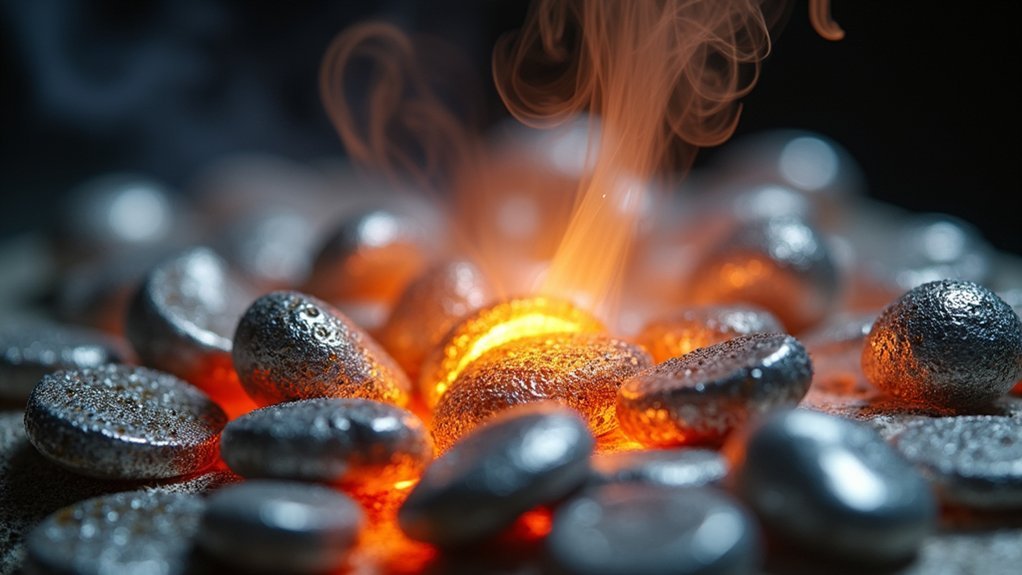You’ll need to prioritize color quality, which accounts for 60% of a gemstone’s worth—focus on hue, saturation, and tone uniformity. Evaluate clarity standards specific to each gemstone type, as emeralds with inclusions can command premium prices while amethysts require near-flawless clarity. Consider geographic origin, which adds approximately 15% to value, especially for Kashmir sapphires. Understand that carat weight pricing increases exponentially, and proper cut quality can boost value by over 10%. Master these fundamentals to reveal deeper valuation insights.
Color Quality Takes Priority in Gemstone Assessment

When evaluating colored gemstones, you’ll find that color dominates every other characteristic in determining value. This single quality accounts for roughly 60% of a gemstone’s overall worth, making it your primary assessment criterion.
You’ll need to examine three critical dimensions: hue, saturation, and tone. These elements work together to create the visual appeal that drives market price.
Pay close attention to color uniformity throughout the stone. Uneven distribution, called color zoning, dramatically reduces value.
You’ll also want to reflect on how the cut enhances color perception—well-executed faceting maximizes a gem’s color potential.
Remember that ideal color ranges vary by gemstone type, with rarity and saturation intensity directly influencing both selling speed and final pricing in today’s competitive gemstone market.
Evaluate Clarity Standards by Gemstone Type
Unlike the standardized clarity grading used for diamonds, colored gemstone clarity standards shift dramatically between species, requiring you to adjust your expectations based on each stone’s geological formation process.
You’ll find that emeralds with visible inclusions can still command premium prices, while amethysts demand near-flawless clarity for maximum value. Each gem species has unique quality factors where inclusions affect market interest differently.
For emeralds, characteristic “jardin” inclusions actually enhance authenticity and value. Kashmir sapphires benefit from microscopic inclusions that create their coveted velvety appearance.
When evaluating clarity grading, consider how inclusions impact the gemstone’s light performance and color display, as these factors determine overall quality and market positioning within each species.
Geographic Origin Adds Premium Value

While clarity standards vary between species, geographic origin creates an entirely separate value tier that can greatly increase a gemstone’s worth.
You’ll find that Kashmir sapphires command markedly higher market prices than identical stones from other locations. The Gemological Institute of America can scientifically determine geographic origin through extensive analysis, validating your colored gemstones’ premium status.
Origin impacts approximately 15% of your gemstone’s value, making it essential for accurate assessment.
Geographic origin significantly influences gemstone valuation, contributing roughly fifteen percent to overall worth and requiring professional verification for accurate market assessment.
When evaluating the value of colored stones, you can’t rely solely on clarity and color or traditional cut grading systems. The gem trade recognizes specific locations for producing superior quality stones.
You’ll need laboratory reports detailing geographic origin to maximize your overall value and avoid misleading trade names that inflate market price expectations.
Carat Weight Impact on Per-Carat Pricing
Beyond origin considerations, carat weight creates its own pricing dynamics that directly affect what you’ll pay per unit of gemstone.
Per-carat prices for colored stones typically increase exponentially as size grows, especially when exceptional clarity and color are present. Large sizes of rare gems command premium pricing, while common varieties may see price drops.
Natural, untreated cut stones maintain higher gemstone value as weight increases due to market preference for authenticity.
- Rarity Factor: Rare colored stones maintain or increase per-carat prices at larger weights, while common gems may decrease in value per unit
- Quality Multiplier: Superior clarity and color create exponential price increases that amplify with each additional carat of weight
- Treatment Impact: Natural, untreated gems receive higher premiums at increased sizes compared to enhanced stones
Cut Quality Maximizes Light Performance and Market Appeal

When evaluating colored gemstones, cut quality serves as the bridge between a stone’s natural beauty and its market value. You’ll find that proper proportions directly enhance light performance, maximizing brilliance and color saturation. Well-executed gem cutting can boost your gemstone’s overall worth by over 10%, while poor craftsmanship creates light leakage that diminishes visual appeal.
| Cut Quality | Market Impact |
|---|---|
| Excellent | +10% value increase |
| Poor | Significant value loss |
| Custom | Maximizes unique potential |
The artistry of managing light entry and exit becomes essential when you’re appraising value. Each unique rough stone demands individualized cutting approaches to optimize its potential. Remember, cut quality ties together the vital factors of color, clarity, and carat weight into one cohesive valuation.
Frequently Asked Questions
Are Colored Stones Worth Anything?
You’ll find colored stones can be quite valuable, depending on their color, clarity, cut, and origin. High-quality rubies, sapphires, and emeralds often command substantial prices, especially when they’re eye-clean and well-cut.
How to Tell if Gemstones Are Valuable?
You’ll determine a gemstone’s value by examining its color intensity and uniformity, clarity level, cut quality, carat weight, and origin. Look for vivid, even color distribution and minimal visible inclusions for higher worth.
How Do I Get Gemstones Valued?
You’ll need to contact a certified gemologist or professional appraisal service. They’ll examine your stones using specialized equipment, assess the Four Cs, and provide detailed reports confirming authenticity, treatments, and current market value.
How Are Colored Gemstones Graded?
You’ll find colored gemstones are graded using the Four Cs: Color, Clarity, Cut, and Carat weight. Color’s most important, considering hue, saturation, and tone, while clarity examines inclusions affecting transparency and value.
In Summary
When you’re valuing colored gemstones, you’ll find success by prioritizing these five key factors. Focus on color quality first, as it’s your most important consideration. Don’t overlook clarity standards that vary by gemstone type. You’ll often pay premiums for stones with prestigious geographic origins. Remember that carat weight affects per-carat pricing differently than with diamonds. Finally, make certain you’re evaluating cut quality to maximize both light performance and market appeal.





Leave a Reply